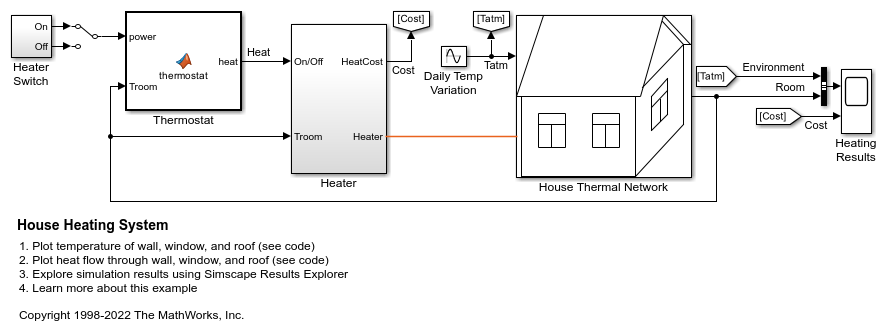Conductive Heat Transfer
伝導による熱伝達
ライブラリ:
Simscape /
Foundation Library /
Thermal /
Thermal Elements
説明
Conductive Heat Transfer ブロックは、同じ材料の 2 つの層間の伝導による熱伝達を表します。平面の場合、伝達はフーリエの法則によって表現されます。
ここで、
Q は熱流量です。
k は材料の熱伝導率です。
A は熱流量の方向に対して法線方向の面積です。
D は層間の距離 (つまり材料の厚さ) です。
TA は層 A の温度です。
TB は層 B の温度です。
丸いパイプの壁を通じた熱伝導は、以下のようになります。
ここで、
L はパイプの長さです。
din は内径です。
dout は外径です。
[伝導タイプ] パラメーターを使用して、熱伝導率を指定できます。
定数— シミュレーション中、熱伝導率は一定に保たれます。[熱伝導率] パラメーターを使用して熱伝導率を指定します。可変入力— 端子 K の入力物理量信号を使用して熱伝導率を指定します。熱伝導率はシミュレーション中に変動する可能性があります。[最小熱伝導率] パラメーターは物理量信号の下限を指定します。表形式データ— 温度に基づいてルックアップ テーブルを使用して熱伝導率を指定します。この場合もシミュレーション中に熱伝導率が変動する可能性があります。
[表形式データ] オプションは、ブロックの平均温度を使用して熱伝導率を求めます。平面壁のジオメトリの場合、平均温度は以下のようになります。
円柱壁のジオメトリの場合、平均温度は以下のようになります。
ここで、TB は円柱の内側にあるものと仮定します。
[A] と [B] は、材料層に関連付けられた熱保存端子です。このブロックの正方向は端子 [A] から端子 [B] であるため、熱流量は、[A] から [B] へ流れる場合に正となります。
変数
シミュレーションの前にブロック変数の優先順位と初期ターゲット値を設定するには、ブロックのダイアログ ボックスまたはプロパティ インスペクターの [初期ターゲット] セクションを使用します。詳細については、ブロック変数の優先順位と初期ターゲットの設定を参照してください。
ノミナル値は、モデル内で予想される変数の大きさを指定する方法を提供します。ノミナル値に基づくシステムのスケーリングを使用すると、シミュレーションのロバスト性が向上します。ノミナル値はさまざまなソースから得られます。その 1 つがブロックのダイアログ ボックスまたはプロパティ インスペクターの [ノミナル値] セクションです。詳細については、ブロック変数のノミナル値の変更を参照してください。




